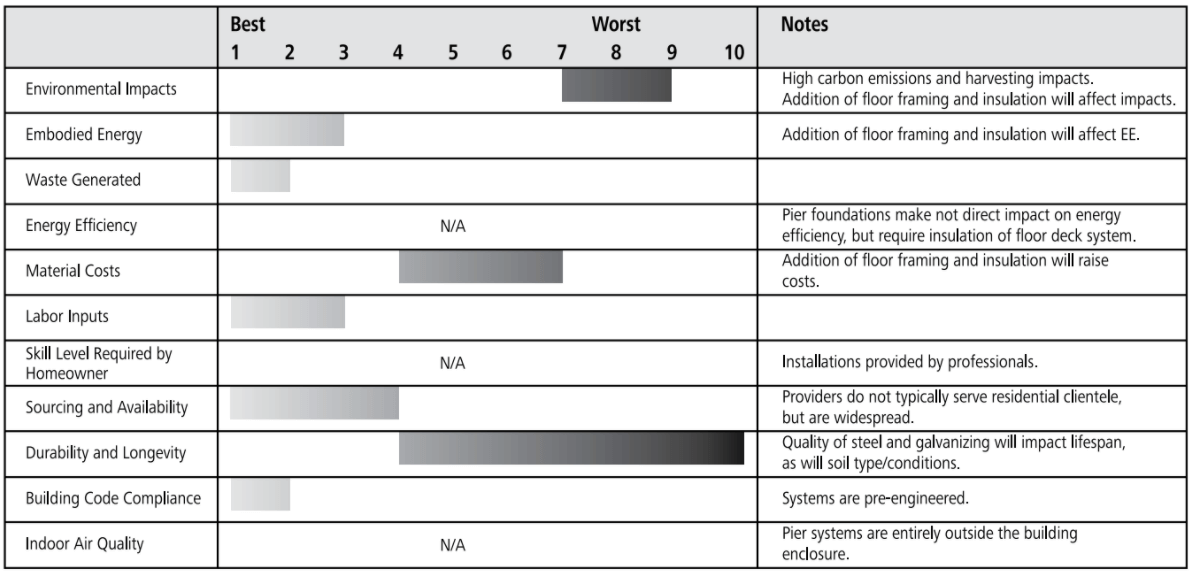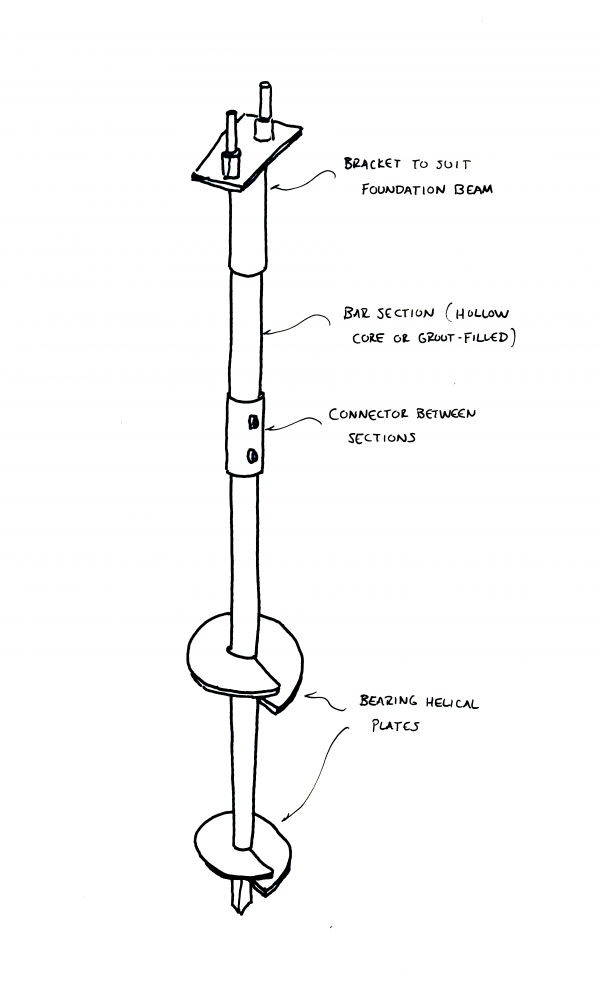Screw Piers
FOUNDATIONS: MATERIALS ENCYcLOPEDIA
Applications for this system
Perimeter Beams
Frost walls
Basement walls
Piers
Slabs
Basic materials
Galvanized steel shafts and helices
Connectors for beams
Torque equipment (manual or hydraulic)
Ratings Chart for Screw Pier Foundation

The ratings chart shows comparative performance in each criteria category. Click on the tabs below for detailed analysis of each criteria.
- HOW THE SYSTEM WORKS
- ENVIRONMENTAL IMPACTS
- WASTE
- EMBODIED CARBON
- ENERGY EFFICIENCY
- MATERIAL COSTS
- LABOUR INPUT
- SKILL LEVEL REQUIRED
- SOURCING & AVAILABILITY
- DURABILITY
- CODE COMPLIANCE
- INDOOR AIR QUALITY
- RESOURCES
- FUTURE DEVELOPMENT
screw pier system

A galvanized steel shaft (round or square section tubing) with screw-like flanges is twisted into the ground until the torque required to turn it indicates proper bearing capacity of the soil. Depending on soil conditions and loads, this can happen just below the frost line or hundreds of feet down. For deep piers, the screw is driven down in sections with additional steel shafts added as required. A desired amount of the steel shaft is left above grade and a cap appropriate to the style of foundation is placed or welded on top. The lack of excavation and site disturbance can reduce impacts on the local ecosystem.
Helical piers can be used directly as footings for timber or steel posts or to support beams for a raised floor deck. They can also support concrete perimeter beams, concrete slabs or underpin basement wall footings in areas where the surface soils do not provide adequate bearing capacity.
The piers can be driven into most types of ground, though solid rock requires pre-drilling and will be considerably more expensive. Stony soils can work, as the screws tend to push rocks out of their way. Occasionally, a pier being driven into stony soil may hit a boulder it cannot shift or penetrate — in these cases the pier is extracted and slightly relocated or driven at an angle to avoid the obstacle. These occurrences can be hard to predict and will add unexpected cost to the installation.
Most pier companies provide engineering services to calculate building loads and create a pier layout that matches the building’s requirements and the soil conditions. Installations with no unexpected conditions are quite fast and require no excavation, leaving sites with little or no disturbance of the topsoil or subsoil.
Environmental Impact Rating
Harvesting — High
The steel and zinc are extracted in an intensive mining process, with impacts that include habitat destruction, ground and surface water contamination and dangerous/unhealthy working conditions. The use of recycled content can mitigate these impacts.
Manufacturing — High
Steel and zinc are produced using very high heat input, requiring heavy use of fossil fuels. Impacts include air pollution, water contamination and dangerous/unhealthy working conditions. Recycled content is subject to the same intensity of production and does not mitigate impacts.
Transportation — High
Sample building uses 175.5 – 487.5 kg of material:
0.26 – 0.75 MJ per km by 15 ton truck
0.16 – 0.46 MJ per km by 35 ton truck
It can be difficult to track all stages of steel production as there are multiple stages of extraction and manufacture involved which are often international in scope. Components of helical piers may have traveled internationally prior to site of final manufacturing.
Installation — Negligible
The use of helical pier foundations can eliminate the need for excavation of the building site, mitigating one of the highest impacts on the local ecosystem. The use of hydraulic equipment to drive piers will typically have lower impacts than excavation.
Waste: very low
Recyclable — Metal pier offcuts, fasteners.
Chart of Embodied energy & carbon
Energy Efficiency: n/a
Helical piers in residential construction are used to support structural elements and are typically outside the building enclosure. As such, they don’t have a direct impact on energy efficiency.
Piers are often used to build raised floor decks, in which the floor of the building is elevated above grade and the bottom side of the floor system is exposed to the air. When decoupled from the ground, the underside of a floor system is exposed to greater fluctuations in temperature in cold climates and an insulation strategy must be chosen to deal with this exposure. In such cases, the floor insulation should be at least as thick as the walls, and the same attention must be paid to avoiding thermal bridging and air leakage.
Material costs: moderate to high
Helical piers themselves are not particularly expensive, but the complete costs of a helical pier foundation must include geotechnical analysis of soils, pier engineering and installation, all of which will depend on regional conditions and competition.
If soil conditions would require a large volume of fill for a foundation, helical piers will compare favorably. The speed at which they can be installed and the fact that installation is not weather-dependent can save money in many cases. A builder can also save because making access roads for excavators and gravel/cement delivery adds costs to the entire project that may be eliminated by switching to piers.
Labour Input: low
Beyond laying out the pier locations, there is little labor for an owner or builder to contribute to a helical pier installation. Most pier installers send a team of two or three to a residential installation, and a full day is typically all that is required.
Skill level required for homeowners: n/a
Since the supplier does most pier installations, the owner or contractor needs no experience or skill. The owner can do the pier layout as most pier foundations have simple grid layouts that do not require a great deal of skill to create.
Sourcing & availability: moderate
There are numerous pier manufacturers in North America, and suppliers/installers who work regionally with their products. This type of foundation is moderately easy to source and widely available.
Durability: High
Some buildings (mostly lighthouses) built with cast iron screw piles in the mid-1800s are still standing today. This gives some indication that the lifespan of galvanized screw piles should be considerable. Corrosion will eventually destroy the piers, but it is reasonable to measure assumed lifespan in centuries, not decades.
Code compliance:
Residential building codes do not typically address the use of helical piers as a prescriptive solution. However, building departments will likely be familiar with this system from commercial construction. The engineering support supplied by installer should suffice for approval in most jurisdictions.
Indoor air quality
Screw pier foundations will have little direct impact on indoor air quality. By keeping the floors and walls of the building dry they can help to prevent other IAQ issues.
Resources for further research
Perko, Howard A. Helical Piles: A Practical Guide to Design and Installation. Hoboken, NJ: Wiley, 2009. Print.
Future development
Screw pile technology was introduced in the 1830s and the basic premise and design have not changed much since. Developments in metallurgy (in particular, hot-dip galvanizing) have ensured higher strengths and longer lifespan. Experimental piers using carbon fiber and other composites have seen some use, and may become more commercially viable in the future. Such piers may have longer lifespans and higher strength, as well as lower shipping costs due to reduced weight.
Tips for a successful screw pier foundation
1. Consult the pier company early in the planning process. Small changes in pier placement and loads can sometimes make large differences in cost. Different sizes of pier shafts and helices have different costs; costs will vary with fewer, larger piers or more, smaller piers.
2. Perform a geotechnical investigation of your site before committing to helical piers. There will be a cost for this, but the information is valuable. A geotech report will give the pier company accurate information for specifying loads and sizing piers and help avoid any surprises during the installation.
3. Ensure that the bracketry for the piers is compatible with your posts and/or beams. Custom bracketry can add considerable extra cost.
4. Check with your building department regarding their requirements for helical pier installations. The engineering that is done by the pier company should satisfy all code requirements, but as an unusual residential foundation system it is best to bring the idea to the building department early in the process.




